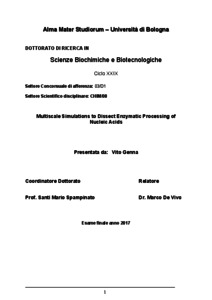Genna, Vito
(2017)
Multiscale Simulations to Dissect Enzymatic Processing of
Nucleic Acids, [Dissertation thesis], Alma Mater Studiorum Università di Bologna.
Dottorato di ricerca in
Scienze biochimiche e biotecnologiche, 29 Ciclo. DOI 10.6092/unibo/amsdottorato/7994.
Documenti full-text disponibili:
![[img]](http://amsdottorato.unibo.it/7994/1.hassmallThumbnailVersion/Thesis_final_sub.pdf)  Anteprima |
|
Documento PDF (English)
- Richiede un lettore di PDF come Xpdf o Adobe Acrobat Reader
Disponibile con Licenza: Salvo eventuali più ampie autorizzazioni dell'autore, la tesi può essere liberamente consultata e può essere effettuato il salvataggio e la stampa di una copia per fini strettamente personali di studio, di ricerca e di insegnamento, con espresso divieto di qualunque utilizzo direttamente o indirettamente commerciale. Ogni altro diritto sul materiale è riservato.
Download (44MB)
| Anteprima
|
Abstract
Nucleic acid polymerization is a key process for genetic inheritance in all living cells. This is performed by a set of DNA/RNA polymerases (Pols) that are effective drug targets in nove therapies. However, DNA damages represent an obstacle for the replication machinery. Here, the role of trans-lesion synthesis polymerases, like DNA Polymerase-η (Pol-η), stand out. Pol-η bypasses ultraviolet-induced basing its function on a highly flexible and conserved R61 and on a transient third ion resolved at the catalytic site in post-reactive state. Nevertheless, how these element assist damaged-DNA replication is still poorly understood. We unravel a highly cooperative mechanism for DNA repair performed by human Pol-η that, via specific R61 conformations, assists the recruitment of the (nucleotide-triphosphate) dNTP in pre-reactive state and ehnances pyrophosphate leaving in post-reactive state.
Moreover, bioinformatics analysis revealed that the dNTP always forms an intramolecular H-bond upon formation of the Michaelis-Menten complex. This previously unrecognized H-bond implies a novel self-activated mechanism (SAM), which synergistically connects the in situ nucleophile formation with subsequent nucleotide addition and nucleic acid translocation. Thus, SAM allows an elegant closed-loop sequence of chemical and physical steps for Pols catalysis. Our proposed mechanism is corroborated via ab initio QM/MM simulations on Pol-η. The structural conservation of DNA/RNA Pols supports the extension of SAM to all Pols.
Finally, we identified key amino-acids and cations optimally placed nearby the active site of two-metal-ion enzymes and ribozymes such as group-II intron. Such elements interact with the reactants and orient the substrates into the active site, being therefore indispensable for catalysis. Our analysis suggests an unprecedented extension of the two-metal-ion architecture in DNA and RNA polymerases, nucleases and ribozymes. In spite of different biopolymer scaffolds, size and biological function, these enzymes have surprisingly preserved previously-unrecognized positively-charged elements at conserved structural positions to aid DNA and RNA processing.
Abstract
Nucleic acid polymerization is a key process for genetic inheritance in all living cells. This is performed by a set of DNA/RNA polymerases (Pols) that are effective drug targets in nove therapies. However, DNA damages represent an obstacle for the replication machinery. Here, the role of trans-lesion synthesis polymerases, like DNA Polymerase-η (Pol-η), stand out. Pol-η bypasses ultraviolet-induced basing its function on a highly flexible and conserved R61 and on a transient third ion resolved at the catalytic site in post-reactive state. Nevertheless, how these element assist damaged-DNA replication is still poorly understood. We unravel a highly cooperative mechanism for DNA repair performed by human Pol-η that, via specific R61 conformations, assists the recruitment of the (nucleotide-triphosphate) dNTP in pre-reactive state and ehnances pyrophosphate leaving in post-reactive state.
Moreover, bioinformatics analysis revealed that the dNTP always forms an intramolecular H-bond upon formation of the Michaelis-Menten complex. This previously unrecognized H-bond implies a novel self-activated mechanism (SAM), which synergistically connects the in situ nucleophile formation with subsequent nucleotide addition and nucleic acid translocation. Thus, SAM allows an elegant closed-loop sequence of chemical and physical steps for Pols catalysis. Our proposed mechanism is corroborated via ab initio QM/MM simulations on Pol-η. The structural conservation of DNA/RNA Pols supports the extension of SAM to all Pols.
Finally, we identified key amino-acids and cations optimally placed nearby the active site of two-metal-ion enzymes and ribozymes such as group-II intron. Such elements interact with the reactants and orient the substrates into the active site, being therefore indispensable for catalysis. Our analysis suggests an unprecedented extension of the two-metal-ion architecture in DNA and RNA polymerases, nucleases and ribozymes. In spite of different biopolymer scaffolds, size and biological function, these enzymes have surprisingly preserved previously-unrecognized positively-charged elements at conserved structural positions to aid DNA and RNA processing.
Tipologia del documento
Tesi di dottorato
Autore
Genna, Vito
Supervisore
Dottorato di ricerca
Ciclo
29
Coordinatore
Settore disciplinare
Settore concorsuale
Parole chiave
DNA, RNA, Molecular Dynamics, Ab initio, QM/MM, Catalysis, Polymerases
URN:NBN
DOI
10.6092/unibo/amsdottorato/7994
Data di discussione
19 Aprile 2017
URI
Altri metadati
Tipologia del documento
Tesi di dottorato
Autore
Genna, Vito
Supervisore
Dottorato di ricerca
Ciclo
29
Coordinatore
Settore disciplinare
Settore concorsuale
Parole chiave
DNA, RNA, Molecular Dynamics, Ab initio, QM/MM, Catalysis, Polymerases
URN:NBN
DOI
10.6092/unibo/amsdottorato/7994
Data di discussione
19 Aprile 2017
URI
Statistica sui download
Gestione del documento:


 Login
Login
